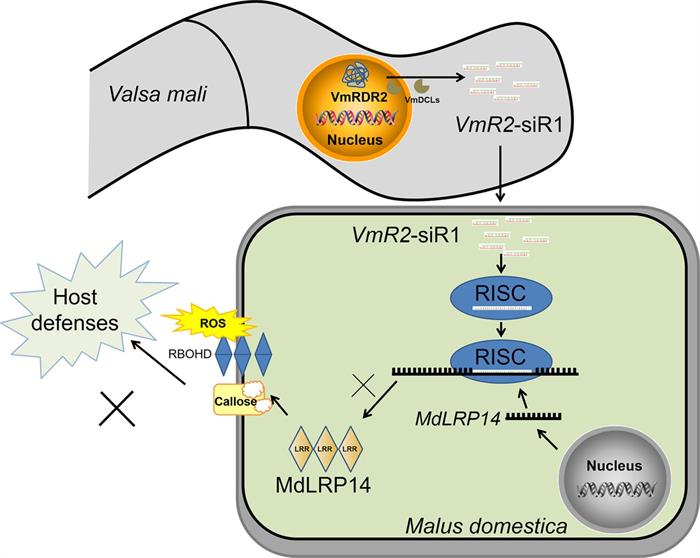Recently, Prof. Huang Lili's research group from our college, Research Center of Fruit Tree Diseases and Pests Management in Northwest A&F University, published a research paper titled VmRDR2 of Valsa mali mediates the generation of VmR2-siR1 that suppresses apple resistance by RNA interference in the journal New Phytologist. Through deep sequencing, molecular biology, genetics, and biochemical methods, this study revealed the mechanism of the VmRDR2 gene of the apple tree canker pathogen (Valsa mali) inhibiting the expression of apple disease resistance-related genes by regulating the generation of VmR2-siR1, thereby suppressing apple disease resistance. Liang Jiahao, a doctoral student of our college, is the first author of this paper, with Prof. Huang Lili and Prof. Feng Hao as the corresponding authors.
RNA interference (RNAi) is a highly conserved gene silencing mechanism mediated by non-coding small RNAs (sRNAs) that exists widely in eukaryotes and participates in various biological processes. Recent studies have found that RNAi plays a crucial role in the interaction between plants and pathogens. However, the mechanism of how pathogenic fungi utilize the RNAi mechanism, especially the role of signal amplification component RdRP in sRNA generation and regulation of plant defense response, has not been reported yet.
This study first discovered that V. mali has two homologous VmRDR1 and VmRDR2, both containing the conserved RdRP domain. After the deletion of VmRDR2, the pathogenicity of the pathogen was significantly reduced, and after the deletion of both VmRDR1 and VmRDR2, the pathogenicity was extremely reduced, indicating its crucial role in the infection process of V. mali. Subsequent sRNA sequencing analysis revealed that the deletion of VmRDR2 significantly reduced the sRNA abundance of the pathogen, especially affecting the generation of endogenous small interfering RNA (siRNA). Further analysis of the most significant VmR2-siR1 revealed that VmR2-siR1 positively regulates the pathogenicity of the pathogen, and degradome sequencing combined with related experiments found that VmR2-siR1 can specifically degrade the expression of the apple MdLRP14 gene. Further research found that overexpression of MdLRP14 can enhance apple resistance to V. mali, while the presence of VmR2-siR1 can inhibit this resistance. Additionally, silencing the MdLRP14 gene also reduces apple disease resistance. This study is the first to reveal how the canker pathogen utilizes RdRP in the RNAi pathway to suppress the host apple's defense response, providing a new perspective on understanding the role of cross-kingdom RNAi in plant-pathogen interactions and providing important scientific evidence for exploring the complex interactions between plants and pathogens.

Schematic diagram of the mechanism of VmRDR2's involvement in cross-kingdom RNAi during the infection process of Valsa mali in apple trees.
The experimental platform of our college, State Key laboratory for Crop Stress Resistance and High-Efficiency Production, provided technical support for this research. And the research was funded by the National Natural Science Foundation of China (U1903206, 3217237559) and the General Program of Natural Science Basic Research Plan of Shaanxi Province (2019JM-418).
Original link: https://nph.onlinelibrary.wiley.com/doi/10.1111/nph.19867